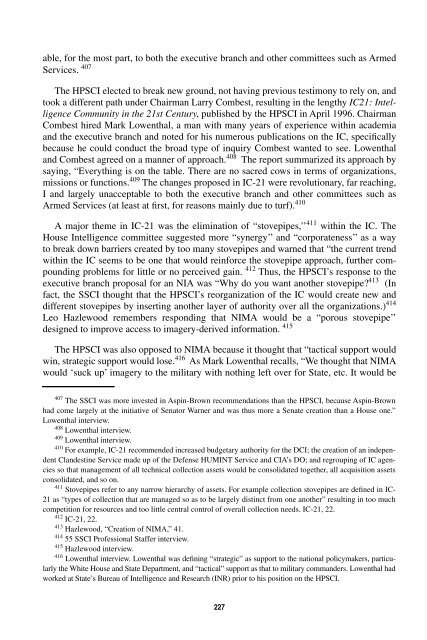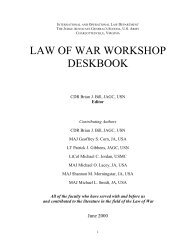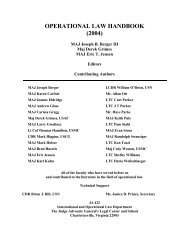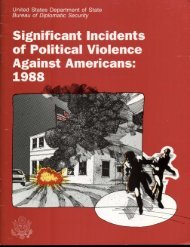learning with professionals - Higgins Counterterrorism Research ...
learning with professionals - Higgins Counterterrorism Research ...
learning with professionals - Higgins Counterterrorism Research ...
Create successful ePaper yourself
Turn your PDF publications into a flip-book with our unique Google optimized e-Paper software.
able, for the most part, to both the executive branch and other committees such as Armed<br />
Services. 407<br />
The HPSCI elected to break new ground, not having previous testimony to rely on, and<br />
took a different path under Chairman Larry Combest, resulting in the lengthy IC21: Intelligence<br />
Community in the 21st Century, published by the HPSCI in April 1996. Chairman<br />
Combest hired Mark Lowenthal, a man <strong>with</strong> many years of experience <strong>with</strong>in academia<br />
and the executive branch and noted for his numerous publications on the IC, specifically<br />
because he could conduct the broad type of inquiry Combest wanted to see. Lowenthal<br />
and Combest agreed on a manner of approach. 408 The report summarized its approach by<br />
saying, “Everything is on the table. There are no sacred cows in terms of organizations,<br />
missions or functions. 409 The changes proposed in IC-21 were revolutionary, far reaching,<br />
I and largely unacceptable to both the executive branch and other committees such as<br />
Armed Services (at least at first, for reasons mainly due to turf). 410<br />
A major theme in IC-21 was the elimination of “stovepipes,’’ 411 <strong>with</strong>in the IC. The<br />
House Intelligence committee suggested more “synergy’’ and “corporateness’’ as a way<br />
to break down barriers created by too many stovepipes and warned that “the current trend<br />
<strong>with</strong>in the IC seems to be one that would reinforce the stovepipe approach, further compounding<br />
problems for little or no perceived gain. 412 Thus, the HPSCI’s response to the<br />
executive branch proposal for an NIA was “Why do you want another stovepipe? 413 (In<br />
fact, the SSCI thought that the HPSCI’s reorganization of the IC would create new and<br />
different stovepipes by inserting another layer of authority over all the organizations.) 414<br />
Leo Hazlewood remembers responding that NIMA would be a “porous stovepipe’’<br />
designed to improve access to imagery-derived information. 415<br />
The HPSCI was also opposed to NIMA because it thought that “tactical support would<br />
win, strategic support would lose. 416 As Mark Lowenthal recalls, “We thought that NIMA<br />
would ‘suck up’ imagery to the military <strong>with</strong> nothing left over for State, etc. It would be<br />
407 The SSCI was more invested in Aspin-Brown recommendations than the HPSCI, because Aspin-Brown<br />
had come largely at the initiative of Senator Warner and was thus more a Senate creation than a House one.”<br />
Lowenthal interview.<br />
408 Lowenthal interview.<br />
409 Lowenthal interview.<br />
410 For example, IC-21 recommended increased budgetary authority for the DCI; the creation of an independent<br />
Clandestine Service made up of the Defense HUMINT Service and CIA’s DO; and regrouping of IC agencies<br />
so that management of all technical collection assets would be consolidated together, all acquisition assets<br />
consolidated, and so on.<br />
411 Stovepipes refer to any narrow hierarchy of assets. For example collection stovepipes are defined in IC-<br />
21 as “types of collection that are managed so as to be largely distinct from one another” resulting in too much<br />
competition for resources and too little central control of overall collection needs. IC-21, 22.<br />
412 IC-21, 22.<br />
413 Hazlewood, “Creation of NIMA,” 41.<br />
414 55 SSCI Professional Staffer interview.<br />
415 Hazlewood interview.<br />
416 Lowenthal interview. Lowenthal was defining “strategic” as support to the national policymakers, particularly<br />
the White House and State Department, and “tactical” support as that to military commanders. Lowenthal had<br />
worked at State’s Bureau of Intelligence and <strong>Research</strong> (INR) prior to his position on the HPSCI.<br />
227

















